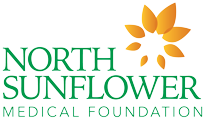Memorial and Honorarium Giving
The next time you are faced with searching for a way to help express your feelings, consider an honorary or memorial gift that will be recognized and appreciated by others for years to come. A gift to North Sunflower Medical Foundation can be a fitting, personal way to honor the memory or successes of a loved one, or mark other milestones in life.
When the tribute is in memory of someone dear, the Foundation will notify the family of your kind act, but will not disclose the amount of your donation. The following are excellent occasions for donating:
- Anniversary
- Birthday
- Christmas
- Easter
Annual Giving Program
Members of the Annual Giving Program provide a source of support that North Sunflower Medical Center can count on, year after year. Donors make an annual contribution and are recognized at different giving levels.
Endowments
Charitable Estate Planning
Each year, the Foundation receives bequests and other planned gifts from donors with the foresight to plan for the future. Planned gifts can include such things as:
Bequests in Wills and Living Trusts
Perhaps the best-known method of creating a legacy, a bequest in your will or trust is a wonderful way to benefit future generations by your philanthropy. You may transfer any type of property: cash, stock, real estate, etc. You may transfer a fixed amount, a fixed percent, or the “residue” of your estate left after taking care of other beneficiaries.
Life Insurance
Naming the Foundation as beneficiary or partial beneficiary of a life insurance policy is the easiest way to create a legacy. All you need to do is sign a beneficiary designation form. If you use group life insurance, there may be income tax benefits as well as estate tax benefits. Older policies that are no longer needed (such as GI insurance) can be donated to the Foundation, entitling you an income tax deduction.
Pensions, IRAs and Annuities
Retirement plans are subject to double taxation (income taxes and estate taxes), so these are often the best assets for creating a legacy. In some cases, the combination of income and estate taxes can deplete a retirement plan by 70 percent or more. Naming the Foundation as the beneficiary of your retirement plans can save both income and estate taxes, creating maximum tax “leverage.”
Remainder Interest in Residence
You can get a current income tax deduction by giving the Foundation a remainder interest in your home, while you continue to live there.
Charitable Remainder Trusts
A charitable remainder trust is a way to “have your cake and eat it, too”. You create a trust, donate property to that trust, and the trust makes regular payments to you or someone you designate. You choose the payout rate. (No less than 5%; not more than 50%). A charitable remainder trust can be an excellent way to convert non-income producing investments to income-producing, to minimize capital gains taxes on appreciated property, and to supplement your income, as well as creating a legacy. The tax laws provide income, capital gains, and estate tax benefits for establishing a charitable remainder trust.
Charitable Lead Trusts
You can set up a trust that makes annual payments to the Foundation for a number of years. At the end of that time, the trust can come back to you, or go to your family. A lead trust established at death, with ultimate distribution to your grandchildren, can make a fine legacy.
Charitable Gift Annuities
You can give property to the Foundation in return for the Foundations promise to make payments to you for the rest of your life. The payout rate and tax benefits depend on your age. You can choose to have the payments begin immediately, or you can defer the payments so that they supplement your retirement income in the future.
Recognition Given To Donors
North Sunflower Medical Foundation is grateful for all its donors. Every gift to North Sunflower Medical Foundation is recognized in our annual publication. Whenever possible, contributions are further honored by plaques on equipment, patient rooms or other patient care areas.
